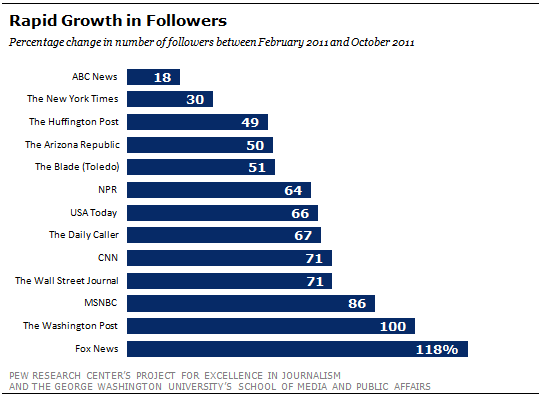The online social networking and messaging service Twitter (also referred to as a micro-blogging tool) was launched on July 15, 2006. By 2011, it was reported to have around 200 million global users.[1] And as of June 2011, 13% of online Americans reported using Twitter, according to data from the Pew Internet & American Life Project, up from sharply from 8% in November 2010.
The confines of the tool, not unlike text messaging (SMS or Short Message Service), are its most distinguishing feature. Individual "tweets" are limited to 140 characters, truncating what any one individual, organization, institution or brand can communicate in a single post. Anyone can search and find Twitter feeds that might interest them either by searching by name, by topic or by "hashtags," a designated topic code that users can assign to a topic or event.[2] Users can also choose to "follow" a Twitter feed, which means they receive all of the posts from that outlet or individual. In the news context, this allows users to curate their own news. If a user "retweets" the post (essentially placing someone else’s post in their own Twitter feed), the ultimate reach of the original post can potentially multiply many times over.

Among the outlets that were studied, Twitter activity varied widely.
One way they differed was in the overall number of separate organizational Twitter feeds or channels offered.[3] On average, the outlets studied offered 41 organizational Twitter feeds, ranging from the general-such as politics-to the narrow-such as Civil War or cycling. The Washington Post offered the largest number of separate feeds, at 98. The Daily Caller, a conservative web-only news operation led by former cable personality Tucker Carlson, offered the fewest, a single feed.[4]
Major national newspapers tend to offer the most: As a group the four papers studied average 74. The three cable news channels average 45. The rest of the outlets studied-broadcast television, audio, online-only and local newspapers-average 18 Twitter feeds per outlet.
The other point of variation was how many tweets outlets offered. The level of daily activity ranged widely.
When it came to the main organizational Twitter feed, The Washington Post tweeted most, with 664 different tweets over the course of the week studied (February 14-20, 2011). That was followed by The Huffington Post (415 tweets) and The New York Times (391).

The three cable news channels, meanwhile, tweeted the least in the general Twitter feed. MSNBC offered just 33 tweets during the week, Fox 48 and CNN 90.
One question raised by the researchers was whether some of these outlets might use other organizational Twitter feeds to a greater extent than the main one studied here. To test that, researchers tallied all the Twitter posts across all the feeds at each of these outlets. They found that, for most sites, the main Twitter feed either led are ranked near the top in terms of daily activity, and thereby aptly reflects the ranking. The one exception came in cable news. For these outlets, which in many ways pioneered the concept of 24-hour news, their "breaking news" feed was the most active. On the day captured, for instance, CNN’s breaking news feed produced 29 tweets (its main news feed produced 13); Fox News’ breaking news feed produced 113 (its main news feed produced 24); and MSNBC’s breaking news feed produced 68 tweets (its main news feed produced 13).
The Twitter Community
On Twitter, the main public measure of audience reach available is number of "followers"- individuals that have signed up to have all posts from a Twitter feed sent to their own Twitter newsfeed. Following is simple to do-it consists of simply clicking on the "follow" button next to an account. What is not known, though, is whether people ever look at the posts that get sent their way, or whether they actively use their own Twitter account. Thus, the value of a follower is unclear. Nonetheless, having more followers is generally regarded as one sign of success in this realm.

Across the news organizations studied, the number of followers varied dramatically, though that number was not necessarily tied directly to the outlet’s audience size in other platforms (i.e. television ratings or print circulation). CNN had more than twice the number of followers for its main news feed as Fox News did, yet Fox programs have higher ratings on television. The New York Times, which led among national newspapers in number of followers on Twitter, falls behind The Wall Street Journal and USA Today in print circulation.
What emerges more clearly across the board is the degree of growth in followers in just a short period of time. Researchers initially catalogued followers to the main Twitter feeds in February 2011 and then checked them again in October 2011. In that eight-month time period, the main Twitter feeds studied grew their followers an average of 65%.
The amount of growth ranged across the outlets that were studied. Several institutional Twitter feeds doubled or nearly doubled in followers, including Fox News (118%), The Washington Post (100%) and MSNBC (86%). Others had more modest growth, including ABC News (18%) and The New York Times (30%).
Overall, the number of online adults who use Twitter grew 63% in the period between November 2010 and June 2011, according to the Pew Internet & American Life Project.
FOOTNOTES
[1] Shiels, Maggie. "Twitter co-founder Jack Dorsey rejoins company," BBC. March 28, 2011.
[2] The hashtag symbol (#) is used before key words to categorize tweets and helps facilitate searches within Twitter.
[3] This list of feeds does not include individual journalists from these outlets on Twitter, rather, only organizational level news feeds that all share the same brand. Individual journalists are another way in which these news organizations further their presence on Twitter.
[4] The Daily Caller is a young web-only news site, launched in 2010, and is still building up its presence online.


